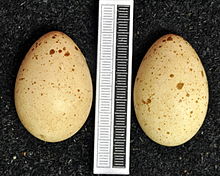Hazel grouse
| Hazel grouse | |
|---|---|

| |
| Scientific classification | |
| Domain: | Eukaryota |
| Kingdom: | Animalia |
| Phylum: | Chordata |
| Class: | Aves |
| Order: | Galliformes |
| Family: | Phasianidae |
| Genus: | Tetrastes |
| Species: | T. bonasia
|
| Binomial name | |
| Tetrastes bonasia | |

| |
| Range of T. bonasia | |
| Synonyms[2] | |
The hazel grouse (Tetrastes bonasia), sometimes called the hazel hen, is one of the smaller members of the grouse family of birds. It is a sedentary species, breeding across the Palearctic as far east as Hokkaido, and as far west as eastern and central Europe, in dense, damp, mixed coniferous woodland, preferably with some spruce. The bird is sometimes referred to as "rabchick" (from рябчик) by early 20th century English speaking travellers to Russia.[3]
Taxonomy
[edit]The hazel grouse was formally described in 1758 by the Swedish naturalist Carl Linnaeus in the tenth edition of his Systema Naturae under the binomial name Tetrao bonasia. Although Linnaeus specified the type locality as Europe, this is restricted to Sweden.[4][5] The hazel grouse is now placed with the Chinese grouse in the genus Tetrastes that was introduced in 1840 by Alexander von Keyserling and Johann Heinrich Blasius.[6] The specific epithet bonasia is Modern Latin for the hazel grouse, from the Italian name for the species.[7]
Eleven subspecies are recognised:[6]
- T. b. rhenanus (Kleinschmidt, 1917) – northeast France, Luxembourg, Belgium and west Germany
- T. b. styriacus (von Jordans & Schiebel, 1944) – Alps, south Poland to Hungary
- T. b. schiebeli (Kleinschmidt, 1943) – Balkan Peninsula
- T. b. rupestris (Brehm, CL, 1831) – south Germany and Czech Rep.
- T. b. bonasia (Linnaeus, 1758) – west, south Scandinavia and central Poland east to the Ural Mountains (Russia)
- T. b. griseonota Salomonsen, 1947 – north Sweden
- T. b. sibiricus Buturlin, 1916 – northeast Russia, north, central Siberia and north Mongolia
- T. b. kolymensis Buturlin, 1916 – east Siberia
- T. b. amurensis Riley, 1916 – northeast China to north Korea Peninsula
- T. b. yamashinai Momiyama, 1928 – Sakhalin (Russia)
- T. b. vicinitas Riley, 1915 – Hokkaido (Japan)



Description
[edit]This is a relatively small grouse at 35–39 cm (14–15 in) length. The plumage of this plump bird is finely patterned, but it essentially has grey upperparts, brown wings and chestnut flecked white underparts.
The male has a short erectile crest and a white-bordered black throat. The female has a shorter crest and lacks the black color on the throat. In flight, this species shows a black-tipped grey tail.
The male has a high-pitched ti-ti-ti-ti-ti call, and the female a liquid tettettettettet. These calls, along with the burr of the flying birds' wings, are often the only indication of this grouse's presence, since its shyness and dense woodland habitat make it difficult to see.
Behaviour and ecology
[edit]Food and feeding
[edit]This bird feeds on the ground, taking mainly plant food, supplemented by insects when breeding.
Breeding
[edit]These birds nest on the ground, with 3–6 eggs being the normal clutch size. The female incubates the eggs and cares for the chicks alone, as is typical with gamebirds.
References
[edit]- ^ BirdLife International (2016). "Bonasa bonasia". IUCN Red List of Threatened Species. 2016: e.T22679494A85936486. doi:10.2305/IUCN.UK.2016-3.RLTS.T22679494A85936486.en. Retrieved 4 June 2022.
- ^ Peterson, Alan P. "Birds of the World — current valid scientific avian names". Retrieved 27 January 2010.
- ^ "Chapter XXIV".
- ^ Linnaeus, Carl (1758). Systema Naturae per regna tria naturae, secundum classes, ordines, genera, species, cum characteribus, differentiis, synonymis, locis (in Latin). Vol. 1 (10th ed.). Holmiae (Stockholm): Laurentii Salvii. p. 160.
- ^ Peters, James Lee, ed. (1934). Check-List of Birds of the World. Vol. 2. Cambridge, Massachusetts: Harvard University Press. p. 37.
- ^ a b Gill, Frank; Donsker, David; Rasmussen, Pamela, eds. (August 2024). "Pheasants, partridges, francolins". IOC World Bird List Version 14.2. International Ornithologists' Union. Retrieved 19 February 2025.
- ^ Jobling, James A. "bonasia". The Key to Scientific Names. Cornell Lab of Ornithology. Retrieved 19 February 2025.

